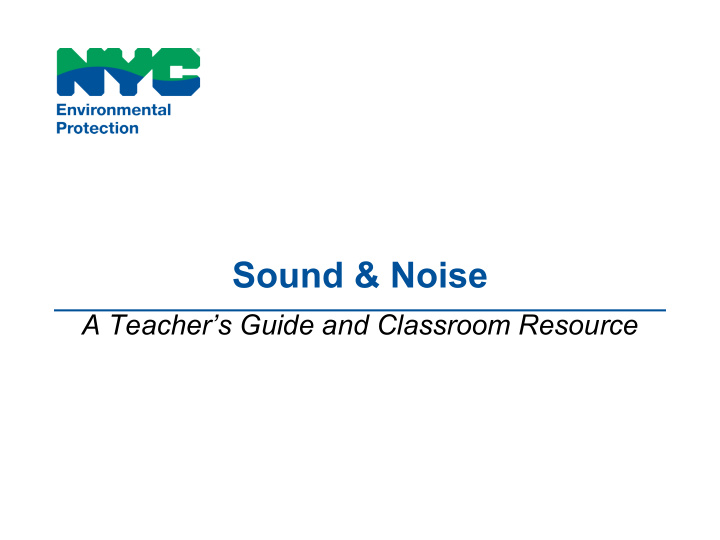



Sound & Noise A Teacher’s Guide and Classroom Resource
Why learn about sound and noise? • Studies of the NYC sound environment have shown adverse impacts of noise to public health, both mental and physical. • Noise pollution can impede learning, concentration, attention, and comprehension. • The school environment and everyday city life is affected by sound and noise. 2
What is the difference between sound and noise? Sound Noise • Vibrations transmitted through air • A sound that is loud, unpleasant, or another medium capable of unexpected, or undesired being detected by human organs of hearing 3
How do we measure sound? • Sounds are caused by vibrations and are measured in units called decibels (dB). • Most sound is measured in dBA, which is the decibel level that follows the frequency sensitivity of the human ear at low levels. • dBA is good for measuring damage to the ear. • Measurements of 85 dBA and higher are defined as harmful sound. • Extended exposure to levels over 85 decibels can cause hearing damage as well as mental and emotional stress. • Please note that sound meters range in their sensitivity and accuracy and that a sound meter phone app (recommended for educational sound measuring) will not be as accurate as the sound meters that DEP noise experts use when they take measurements in response to a noise complaint. 4
Parts of the ear • Ear – the sense organ that detects sounds. • Outer Ear (Pinna) – Acts as a funnel on the outside of the ear that directs sound into the ear. • Ear Canal – a tube running from the outer ear to the inner ear to transmit sound. • Inner Ear (Cochlea) – a hollow tube in the inner ear of higher vertebrates, usually coiled like a snail shell where sound waves are transformed into electrical impulses which are sent on to the brain. 5
What effects can loud sounds and noise have on the ear? • Loud sounds can cause physical damage to different parts of the ear and may lead to hearing loss. Even little things can make big sounds . Have you read “Horton hears a Who”? 6
Noise expert and advocate Dr. Bronzaft is an environmental psychologist. In 1975 she published an unprecedented study at an elementary school in Inwood, Manhattan concluding that students of the school in classrooms facing the train tracks performed less well than students in quieter classrooms. Listen to the Raindrops is the first published children’s story about soundscapes. 7
Noise mitigation in your community • There are many ways to reduce loud sounds in homes, schools, and businesses. o Double-glazed windows o Sound dampening wall panels o Just turn down the volume on your TV, radio, or cellphone! • See also the New York City Noise Code commercial guidelines on noise mitigation 8
What is New York City doing to reduce noise? • The New York City Department of Environmental Protection (DEP) regulates noise in respect to businesses , construction , and stationary vehicles . o Call 311 to report a noise code violation • DEP created and implemented the NYC Noise Code , the regulating document for loud sounds in NYC. o See a PowerPoint by NYC DEP related to the Noise Code here. • Personal noise and noises on the move are regulated by NYC police. • Transit noise, such as subways and airplanes, are regulated by the MTA and the FAA respectively. 9
The New York City Noise Code • New York City classifies noise into seven categories: 1. Construction 2. Animals 3. Food Vendors 4. Air Conditioners 5. Bars and Restaurants 6. Garbage Trucks 7. Motor Vehicles and Motorcycles 10
NYC Noise Complaint Trends Noise complaints to 311, NYC’s information hotline, have increased. Use NYC Open Data to investigate noise complaints and other quality of life data. 11
Thank You! For more information about sound and noise, visit: www.nyc.gov/dep. For more education resources, contact: educationoffice@dep.nyc.gov. 12
Recommend
More recommend